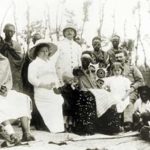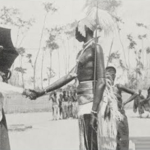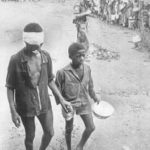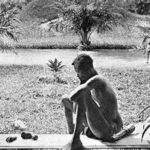Administrative Unification In KINYAGA
When German authorities established themselves in Rwanda they embarked upon a policy of indirect rule, using existing traditionaln authorities to govern the country for them, supposedly without altering existing patterns of authority. In fact, the very presence of the Europeans and the new resources they brought with them had a profound impact on power relations, both among elites and between ruling groups and the governed. Yet it was Rwandans who largely determined the ways in which colonialism influenced the transformation of clientship ties. European rule also introduced
new policies on recruitment to political office and the organization of administrative structures. The discussion below examines how Rwandan groups and individuals participatein and influenced this process.
After the departure of the Abapari, and in the wake of the Rucunshu coup, a fierce struggle occurred between two central chiefs with claims on overlapping political commands in Kinyaga. Rwidegembya, a member of the Abakagara lineage, attempted to enlarge his role as umuheto chief of the Impara Province. He engaged in a protracted struggle to dislodge Rwabirinda, the provincial chief of Impara. The conflict was more than a simple attempt by Rwidegembya to augment his area of command; it was part of the larger Abakagara–Abahindiro conflict: Rwabirinda, a member of the Abahindiro lineage, was a son of Rwabugiri, and thus a half-brother of the deceased King Rutarindwa.
The Abakagara won this duel, for in 1905 Rwidegembya secured Rwabirinda’s dismissal from his umuheto command in Impara. Rwidegembya then combined two official roles in Kinyaga—provincial chief and umuheto chief of Impara. But, like other influential chiefs involved in central politics, Rwidegembya spent most of his time at the court (at Nyanza, now called Nyabisindu, in the present Gitarama Prefecture). Also, like other central chiefs of the time, Rwidegembya held commands in several different regions, and so he left local day-to-day administration to his delegates. In Kinyaga, he chose delegates from among the leaders of prominent local lineages. They were left relatively free rein to consolidate their power —and, with aid from the Germans installed in the Impara region, this was what they proceeded to do.
In Abiiru, the royal court appointed a central chief, Nyamuhenda, son of Kajeje, to govern after Rucunshu. Altering the policies of his predecessor, Rubuga, this new chief introduced hill chiefs from outside Kinyaga, using his own trusted followers from his home region of Bufundu. But Nyamuhenda met with recurrent resistance from the people of Abiiru, and in 1910 he “resigned.” Abliru Province then returned to Kinyagan stewardship, when Rubago, a hill chief at Mururu hill, was appointed to replace Nyamuhenda. Later, Rubago was deposed, this time by Belgian authorities, ostensibly for abuses committed by his son Toreero. Although the abuses were real, Rubago’s demise resulted primarily from the plottings of Rwidegembya’s son, Rwagataraka.
During the period after Rucunshu to 1920, Umwami Musinga also granted selected hills in Kinyaga to several trusted foflowers. These delegates were instructed to keep watch on the Europeans there (as well as the chiefs) and to ensure defense of the frontier through magic. Thus, in a modified form, the diversity of administrative arrangements in Kinyaga which had characterized the time of Rwabugiri survived during the first two decades of colonial rule. This diversity was expressed in extreme form by the special, autonomous status of Bukunzi and Busoozo, and by a lack of consistency in lines of control and responsibility in the collection of prestations for Impara and Abiiru provinces.
But from 1917, after the defeat of the German forces in World War I and the introduction of Belgian administration, changes in administrative structures were introduced in Kinyaga and other areas of Rwanda, designed to create larger, more unified regional units. The political structures came to resemble more closely a “feudal” type of government whereby a king holds power over relatively autonomous local lords, each of whom exercises the full range of administrative powers within his own domain.
In Kinyaga the unification of the region was inextricably linked with the career and policies of Rwagataraka, son of Rwidegembya. (and hence a member of the famous Abakagara lineage). Rwagataraka arrived in Kinyaga in 1911 to represent his father, but it was not until after World War I and the establishment of Belgian administration that the dynamic qualities of this ambitions “modernizer” cum “collaborator” came to the fore. Skillfully accommodating to European policies, he gradually eliminated from office any whom he regarded as riyals to his monopoly of power. He filled the vacated positions with his own clients. He recruited some from Kinyaga and others from outside. These efforts to build a local empire pitted Rwagataraka directly against the interests of the royal court, as in his ongoing feud with Birasinyeri.
Birasinyeri came from a family (Abareganshuro lineage, Abanyiginya clan) with longstanding connections in Kinyaga. His father, Seerutabuura, a client of the court, had established umuheto ties with several Kinyagan lineages from early in the nineteenth century, and Birasinyeri himself served as delegate of Rwabirinda for collection of prestations in Impara. Later, when Rwagataraka came to Kinyaga, Birasinyeri was hill chief at Kirambo hill (in northern Impara, an area later established as the province of Cyesha). He was also regional representative of Rwidegembya for collection of prestations in Impara. He enjoyed a semi-autonomous position by virtue of his ties of direct clientship to the king.
Rwagataraka first managed to dislodge Birasinyeri from his hill in northern Impara and from his regional command. When the king then appointed Birasinyeri chief of Abiiru Province (in 1917), Rwagataraka subjected both the chief and his son Ndabikunze to harassment. Some
thirteen years later, Rwagataraka had a hand in the Belgian administration’s decision to remove Birasinyeri. He also used his influence to have Biniga, one of his own protégés, named as successor.
The conflict with Birasinyeri illustrates Rwagataraka’s ambivalent relations with the central court. He depended on the court, yet was jealous of any autonomous power it might preserve in what he came to regard as his “domain.” The powerful position he held in central politics served as a useful resource in the implementation of his goals at the local level, while the remoteness of the royal court at Nyanza inhibited frequent interference by other central chiefs in local affairs. This was another aspect of the continuing theme of autonomy versus status—the attempt by a succession of chiefs to use a regional power base for status at the central court. On another level, it was later the quest for these, autonomy and status that led to the ethnic split in Rwanda.
Rwagataraka’s efforts to expand his domain dovetailed with policy goals of the Belgian authorities. Beginning in 1926, the colonial authorities implemented a program to regroup and consolidate administrative units throughout Rwanda. This plan organized the state into subchiefdoms of roughly equal size, with at least 100 taxpayers in each, and grouped these subchiefdoms into chief doms, following roughly the boundaries of precolonial provinces. Chiefdoms were then grouped into Territories, each headed by a European territorial administrator (“Administrateur de Territoire,” or A. T.). The king appointed chiefs with the consent of the administration; chiefs usually selected their own subchiefs subject to approval by the territorial administrator.
Particularly in line for reconsideration under these policies were the diverse enclaves and intoore hills, which to territorial administrators represented merely a source of extra work. From their point of view, it would be much simpler to appoint a single provincial chief with hierarchical control over all the subchiefs in one area. As a 1929 report complained:
The Territory of Shangugu contains many subchiefs who depend directly on the Mwami… They are currently independent of the native provincial chiefs for prestations in taxes, labor, and cattle, provided that they have received no cattle from a native provincial chef in Shangugu… Until now, these subchiefs, called “abaragu b’u Mwami,” [clients of the king] have been under the direct authority of the [European] Territorial head. This situation leads the Territorial head to enter into constant relations with certain subchiefs who have no great importance, [but need supervision) be-ause of their meddling and impolitic administration, arising from the fact that they are [nothing but] former boys or auxiliary soldiers for the Germans.
The same report recommended the elimination of such “irregular” lines of command, and this was in fact the policy that was adopted. The reforms also envisaged the appointment of European-educated “clerks” (abakaraani). As sons of chiefs they were to attend an official school for a few years to leam basic skills (reading, writing, elementary arithmetic). In later years, such study would be extended to a post-primary program of administrative training.
This reorganization was meant to serve the interests of order and efficiency, making it easier for the Belgian administration to convey and enforce execution of orders along hierarchical channels. The policy was also justified in part (in the European view) by presumed benefits it would have for the general population. Administrative regroupment was supposed to deliver local inhabitants “from the abusive demands of numerous and useless petty chiefs. Since the chiefs are now provided with an income sufficient to satisfy their material needs, exactions [on the population] have become rare.
The regroupment policy had important implications for the role of central (royal) power at the local level. The intoore hills and other enclaves, formerly used by the king to ensure that men loyal to him kept an eye on political activities in the frontier region, existed no longer. The umuheto ties, which had held in check the power of the provincial chiefs, were now aboIished. The result was a diminution of central control in the region and an augmentation of power for the provincial chiefs, for each now governed a single geographically contignous region. In Kinyaga, Rwagataraka was the major beneficiary. During the 1920s and early 1930s, he dismissed or brought under his patronage chiefs who, as direct clients of the king, held individual hills granted them by the royal court. He also exchanged his own hills in other parts of Rwanda with intoore hills in Kinyaga held by other central chiefs.
The convergence of Rwagataraka’s political ambitions with the administrative aims of Belgian authorities is illustrated in their joint action against the small independent kingdom of Bukunzi. From the point of view of the Abakunzi, the Tuutsi chiefs of Kinyaga coveted their cattle. These chiefs complained to the German authorities that the people of Bukunzi and Busoozo should contribute to the food and labor requisitions of the colonial authorities. But until the 1920s neither German administrators nor the Belgians
who followed them succeeded in collecting taxes in Bukunzi, imposing corvée, or even meeting Ndagano, the umwami. In 1907 German authorities had unsuccessfully attempted to capture Ndagano, but later abandoned the undertaking on Musinga’s intervention. In 1909, and again in 1914, German-led forces made forays into Bukunzi but again did not manage to capture Ndagano. In February 1918, a Belgian force raided Bukunzi in retribution for the alleged killing of three men by the local inhabitants. Later that year, Major Declerck (who became Belgian Resident of Rwanda in May 1917) reported that he had decided on a policy of persuasion to gain Ndagano’s surrender. Noting that German military operations against Bukunzi had been unsuccessful, he opted for a policy of persuasion rather than force. But it was not until 1923, when the death of Ndagano triggered conflicts in the small kingdom, that Belgian authorities, aided by Rwagataraka, found the opportunity to subdue this “difficult” region.
Ndagano’s chief wife, Nyirandakunze, planned to place the youngest of her sons, Ngoga, on the throne. To forestall her husband’s expected opposition, she and her brothers arranged to have him poisoned. Nyirandakunze then ordered the execution of two men whose corpses, she maintained, were needed (allegedly as prescribed by tradition) to form the “pillow” of the dead umwami. Conveniently, those she chose to be executed were Men Who posed a threat to her ambitions. The two had been great favorites of Ndagano, and Nyirandakunze had reason to fear they might thwart her plans to install Ngoga as umwami. She also wanted to prevent one of the men, Shyirakeera, a long-time emissary to the Rwandan royal court, from bearing news of her misdeeds to Musinga. Further killings were planned—supposedly of a ritual nature but whose effect would have been to eliminate potential opposition.
Several people from families that were thus threatened, hoping to defend themselves by appealing for outside aid, sought help from the European Catholic missionaries at Mibirizi Mission (adjacent to Bukunzi) and the European governmental administrator at Cyangugu. Their plea received prompt attention. In April 1923 the Belgian administration organized a military foray into the kingdom, credited with having prevented the murder of several people. In the wake of this action, the chief administrator of the region (Administrateur de Territoire, A.T.) assumed direct control over several hills near Mibirizi Mission which had formed part of Bukunzi; he forbade the inhabitants of these hills to work in Bukunzi or to take gifts to the royal family of the small kingdom. And Rwagataraka announced that he had received authorization from Musinga himself to take over Gashashi hill in Bukunzi.
Toward the end of 1923, a new A.T. arrived in Cyangugu, who made it his first’ and urgent priority to conquer the Abakunzi. Shortly afterward, Rwagataraka told the missionaries at Mibirizi that Musinga had granted him control over all the hills of Bukunzi. In the face of these pressures, and hoping to save his kingdom from complete dissolution, Ndagano’s son Bigirumwera (who had assumed interim command of Bukunzi) initiated negotiations with the A.T. at Cyangugu. Using the Mibirizi Mission as intermediary, the A.T. informed Bigirumwera that to demonstrate submission he must produce 50 cows as payment for taxes, 25 cows as a penalty, and 30 men every day tu cut wood in the forest. Further, he was to surrender the guns possessed by the Abakunzi.
When Bigirumwera proved unable to meet all of the demands within the time specified, the A.T. resolved (in April 1924) to invade Bukunzi and arrest Bigirumwera. The invading force lost its way, even though it was accompanied by Rwagataraka and other Kinyagan chiefs, as well as a Kinyagan guide, who knew the proper paths perfectly well. Bigirumwera managed to escape, while Nyirandakunze and her sons remained hidden. The A.T., empty-handed and chagrined, blamed Rwagataraka and reproached him publicly for having misled the expedition. Bigirumwera, who fled across the border to Murenga (in Bupfureero, Zaïre), never was captured.
Bukunzi was then subjected to a regime of military occupation, an extremely harsh form of rule, which lasted for more than two years (until September 1926). Meanwhile, a few months later the umwami of neighboring Busoozo, recognizing the futility of continued resistance, decided to surrender. But it was not until March 1925 that Nyirandakunze and her sons were found. Having managed to wrench information on her whereabouts from a man they had arrested, the Belgians sent a joint European-Kinyagan expedition to attack Nyirandakunze in her cave hideout. She resisted to the last, hurling a spear at the commanding officer of the patrol. The spear missed, and he immediately shot her. Two of her sons were also shot in the fighting, but her son Ngoga surrendered and was sent to prison in Kigali. Several of the Rwandans involved in the expedition suffered injuries, including Rwagataraka, who was wounded on the hand:
Whatever Rwagataraka’s intentions in these events, the outcome was indisputably to his benefit. After the “pacification” of Bukunzi, it fell to Rwagataraka to distribute the booty, in the form of cattle and
political offices. Both Bukunzi and Busoozo were attached to Impara Province, greatly expanding the geographical limits of Rwagataraka’s domain. And as the Belgian regroupment program proceeded and subchiefdoms were created from the former smaller administrative units, Rwagataraka exercised a predominant influence in the appointment of subchiefs. Impara Chiefdom, like the former provinces in other areas of Rwanda, came to be organized along clear, hierarchical lines of control. Rwagataraka, as chief of Impara, presided over subchiefs who had been appointed by him, or who had recognized his authority by becoming his clients—and their tenure in office depended on his continued favor. As one Belgian administrator commented of Rwagataraka, “in fact, all the hill subchiefs in Impara are his abagaragu (followers) and hold cattle distributed directly by him.
By 1933, most of the land area and population of southwest Rwanda was united administratively under a single authority, the chief of Impara. Only Abiiru chiefdom preserved its own chief, responsible to the king; and even there Rwagataraka was attempting to impose control, by contracting client ties and arranging the appointment of a man chosen by him to be chief of Abiiru.
European support was important in Rwagataraka’s ascendance. He was a mode! Chief who fulfilled requests on demand (for tax collection, supplies of food: to European posts, recruitment of workers). He cultivated amicable relations with the Catholic missionaxies -as, for example, when he facilitated the efforts of Father Delmas to establish a Catholic Mission at Nyamasheke (site of Rwabugiri’s residence and later of an Abapari post). He aided Etuopean settlers (colons) who became an important preserite in Kinyaga during the 1920s, and he attempted to maintain cordial relations with Belgian administrators. In return the Europeans reinforced and extended his power.Rwagataraka’s charm and helpfulness impressed many of the Europeans with whom he dealt. Alexander Barns, a British zoologist whom Rwagataraka helped with porters and food during his visit to Kinyaga’s Nyungwe forest in the early 1920s, described the chief in glowing terms:
When I met this gentleman and got to know him a bit, I at once became his friend as well as his great admirer. He was a prince amongst black peoples. Tall—he is six foot seven—broad-shoul-dered, yet slim and graceful with the pride of race stamped indelibly upon him, albeit, a touch of wildness and savagery were written there—no guile. When the man smiled he was captivating, for his teeth were white and even and the whole face seemed to shine and the eyes to sparkle —an effect of his brown-black satiny skin. He wore a slight beard and his hair combed up high on his head. He would certainly make a sensation if he came to London with his appearance alone.
In a 1929 report, the Belgian A.T. Cyangugu lavished praise for Rwagataraka’s collaboration and competence:
Has the exterior bearing of a great Tuutsi chief. Has uncontested authority over his subjects, all the while preserving an imperturbable calm. Like all Tuutsi chiefs is supple and diplomatic. Has a proven devotion, it would seem, to the European authority. . . . The replacement of Rwagataraka would present a serious social disorder, in the case where his replacement was not as rich as he.
Rwagataraka’s policies and European efforts at regroupment had a significant impact on local political configurations in Kinyaga. Administrative consolidation brought together diverse parts of what had been merely a geographical entity with no particular regional identity, and there emerged a conception of “Kinyaga” over and against other regions of Rwanda. Rwagataraka as a dynamic and effective leader became a symbol of Kinyagan pride, however much he may have been resented for particular local policies. One source of strength for Rwagataraka was the support he could count on in central Rwanda against rivals. There was an inherent interdependence between his hold on a local power base, which aided politicking in the central arena, and his powerful position in central politics which he used to augment his power in Kinyaga. But he, like chiefs before him, was also vulnerable to shifts in power at the center.
https://uk.amateka.net/administrative-unification-in-kinyaga/https://uk.amateka.net/wp-content/uploads/2020/05/kinyaga_b.jpghttps://uk.amateka.net/wp-content/uploads/2020/05/kinyaga_b-150x150.jpgChanges and ColonialismWhen German authorities established themselves in Rwanda they embarked upon a policy of indirect rule, using existing traditionaln authorities to govern the country for them, supposedly without altering existing patterns of authority. In fact, the very presence of the Europeans and the new resources they brought with them had...BarataBarata rpierre@ikaze.netAdministratorAMATEKA | HISTORY OF RWANDA




